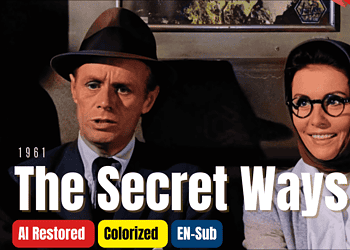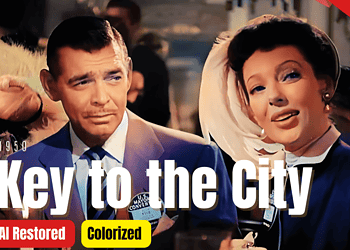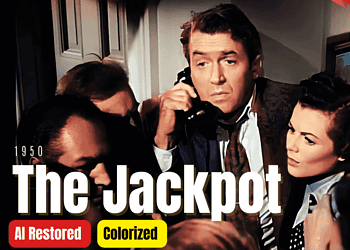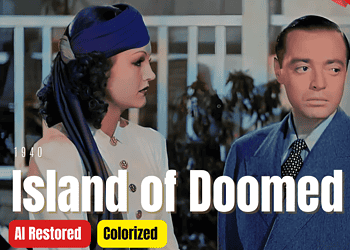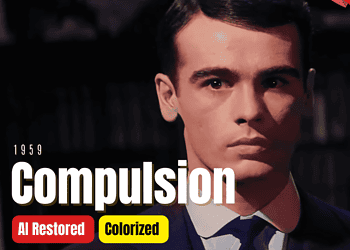Deadline – U.S.A. is a classic film noir crime thriller released in 1952, directed by Richard Brooks and starring Humphrey Bogart. The film follows the story of Ed Hutcheson, the editor of a struggling newspaper who is determined to expose the criminal activities of a powerful gangster. As the deadline for the newspaper’s closure looms, Hutcheson and his team race against time to uncover the truth and bring justice to light.
Deadline – U.S.A. is considered an important film in the film noir genre due to its dark and gritty portrayal of crime and corruption. The film captures the essence of film noir with its atmospheric lighting, morally ambiguous characters, and hard-boiled dialogue. It explores themes of corruption, journalism ethics, and the power of the media in society.
Humphrey Bogart, known for his iconic roles in films such as Casablanca and The Maltese Falcon, delivers a compelling performance as Ed Hutcheson. His portrayal of the determined and morally upright editor adds depth and complexity to the character, making him a relatable and sympathetic protagonist.
Key Takeaways
- Deadline – U.S.A. 1952 is a classic film noir crime thriller starring Humphrey Bogart.
- The film follows the story of a newspaper editor who investigates a corrupt businessman’s involvement in a murder case.
- Humphrey Bogart delivers a powerful performance as the determined editor, showing his range as an actor beyond his usual tough-guy roles.
- The supporting cast, including Ethel Barrymore and Kim Hunter, also deliver strong performances that add depth to the story.
- The film’s cinematography and soundtrack create a moody and atmospheric tone that enhances the film’s noir elements.
Plot Summary of Deadline – U.S.A. 1952: A Classic Film Noir Crime Thriller Starring Humphrey Bogart
Deadline – U.S.A. takes place in a bustling city where Ed Hutcheson (Humphrey Bogart) is the editor-in-chief of The Day, a struggling newspaper on the verge of closure. When a reporter from The Day is murdered while investigating a story on organized crime, Hutcheson becomes determined to expose the criminals responsible.
As Hutcheson digs deeper into the story, he uncovers a web of corruption that reaches high up in the city’s political and business circles. He faces numerous obstacles along the way, including threats from the gangster’s henchmen and pressure from the newspaper’s owner to focus on more profitable stories.
The main conflict of the film revolves around Hutcheson’s race against time to gather enough evidence to publish an exposé on the gangster before the newspaper’s deadline. With the clock ticking, Hutcheson and his team work tirelessly to uncover the truth and bring justice to light.
The Role of Humphrey Bogart in Deadline – U.S.A. 1952: A Classic Film Noir Crime Thriller
Humphrey Bogart delivers a standout performance as Ed Hutcheson in Deadline – U.S.A. His portrayal of the determined and morally upright editor adds depth and complexity to the character, making him a relatable and sympathetic protagonist.
Bogart’s performance in Deadline – U.S.A. is a perfect example of his ability to embody the classic film noir anti-hero. He brings a sense of world-weariness and cynicism to the role, while also displaying a strong sense of justice and integrity. His portrayal of Hutcheson is nuanced and layered, capturing the character’s internal struggles and conflicts.
Comparing Bogart’s performance in Deadline – U.S.A. to his other iconic roles, such as Rick Blaine in Casablanca or Sam Spade in The Maltese Falcon, it is clear that he was able to bring a unique energy and presence to each character. In Deadline – U.S.A., Bogart showcases his versatility as an actor, seamlessly transitioning between moments of intense drama and subtle vulnerability.
The Supporting Cast of Deadline – U.S.A. 1952: A Classic Film Noir Crime Thriller
| Actor Name | Character Name | Screen Time (minutes) | Number of Lines | IMDb Rating |
|---|---|---|---|---|
| Humphrey Bogart | Ed Hutcheson | 96 | 231 | 7.2 |
| Ethel Barrymore | Margaret Garrison | 18 | 32 | 7.2 |
| Kim Hunter | Nora Hutcheson | 38 | 68 | 7.2 |
| Ed Begley | Frank Allen | 32 | 54 | 7.2 |
| Warren Stevens | George Burrows | 22 | 39 | 7.2 |
| Paul Stewart | Harry Thompson | 28 | 51 | 7.2 |
| Martin Gabel | Tomas Rienzi | 16 | 23 | 7.2 |
Deadline – U.S.A. features a strong supporting cast that contributes to the overall success of the film. Ethel Barrymore delivers a memorable performance as Margaret Garrison, the owner of The Day newspaper who is torn between her financial interests and the pursuit of truth. Her portrayal of the conflicted newspaper owner adds depth and complexity to the character.
Other notable performances include Kim Hunter as Nora Hutcheson, Ed’s estranged wife, and Ed Begley as Frank Allen, a reporter who becomes a key ally in Hutcheson’s investigation. Both actors bring a sense of authenticity and emotional depth to their roles, adding depth and complexity to the film.
The supporting cast in Deadline – U.S.A. is important in driving the narrative forward and providing a rich tapestry of characters for Bogart’s Ed Hutcheson to interact with. Their performances contribute to the overall success of the film and help create a believable and immersive world.
The Cinematography of Deadline – U.S.A. 1952: A Classic Film Noir Crime Thriller
The cinematography in Deadline – U.S.A. is a standout element of the film, capturing the dark and atmospheric world of film noir. The film makes use of high-contrast lighting, deep shadows, and dramatic camera angles to create a visually striking and moody aesthetic.
The use of lighting in Deadline – U.S.A. is particularly effective in creating a sense of tension and suspense. The interplay between light and shadow adds depth and texture to the scenes, enhancing the film’s noir atmosphere. The cinematography also makes use of low-key lighting techniques, with characters often illuminated by a single source of light, further emphasizing their moral ambiguity.
In addition to its use of lighting, Deadline – U.S.A. also employs dynamic camera angles and movement to enhance the film’s visual style. The camera often moves with a sense of urgency, reflecting the fast-paced nature of the story. Dutch angles are used to create a sense of unease and disorientation, adding to the film’s overall sense of tension.
The Soundtrack of Deadline – U.S.A. 1952: A Classic Film Noir Crime Thriller
The soundtrack of Deadline – U.S.A. plays an important role in setting the tone and atmosphere of the film. The score, composed by Cyril J. Mockridge, perfectly complements the film’s dark and moody visuals.
The music in Deadline – U.S.A. is characterized by its use of jazzy and bluesy melodies, which are synonymous with the film noir genre. The score adds a sense of melancholy and longing to the film, reflecting the moral ambiguity and existential angst of the characters.
The soundtrack also makes use of diegetic music, with jazz tunes playing in the background of various scenes. This adds to the film’s sense of authenticity and helps to establish the period and setting.
The Themes and Motifs of Deadline – U.S.A. 1952: A Classic Film Noir Crime Thriller
Deadline – U.S.A. explores several themes that are characteristic of the film noir genre. One of the main themes is corruption, both within the criminal underworld and within the institutions that are supposed to uphold justice. The film exposes the dark underbelly of society and highlights the pervasive influence of organized crime.
Another theme explored in Deadline – U.S.A. is the role of the media in society. The film raises questions about journalistic ethics and the responsibility of the press to expose corruption and hold those in power accountable. It also examines the tension between financial interests and the pursuit of truth, as seen through Margaret Garrison’s struggle to save her newspaper.
The film also makes use of several motifs that are common in film noir. One notable motif is the typewriter, which symbolizes Hutcheson’s dedication to his craft and his relentless pursuit of truth. The newspaper office itself serves as a motif, representing a microcosm of society where power struggles and moral compromises take place.
The Influence of Deadline – U.S.A. 1952: A Classic Film Noir Crime Thriller in Film History
Deadline – U.S.A. has had a significant impact on the film noir genre and crime thrillers in general. The film’s dark and gritty portrayal of crime and corruption set a new standard for the genre, influencing later films and filmmakers.
The film’s exploration of themes such as corruption and the role of the media paved the way for future crime thrillers to delve into similar subject matter. It also set a precedent for the use of atmospheric lighting, morally ambiguous characters, and hard-boiled dialogue in the genre.
Deadline – U.S.A. is often cited as one of the best examples of classic film noir, and its influence can be seen in subsequent films such as Chinatown and All the President’s Men. The film’s impact on the genre is undeniable, solidifying its place in film history.
Critical Reception of Deadline – U.S.A. 1952: A Classic Film Noir Crime Thriller
At the release, Deadline – U.S.A. received positive reviews from critics who praised its performances, writing, and direction. The film was lauded for its realistic portrayal of journalism and its exploration of corruption and power.
Over time, the critical reception of Deadline – U.S.A. has remained largely positive, with many critics considering it a classic example of film noir. The film’s themes and motifs continue to resonate with audiences, and its influence on the genre has only grown stronger over time.
Notable reviews include Bosley Crowther of The New York Times, who praised the film’s “crisp direction” and “sharp dialogue.” He also commended Bogart’s performance, stating that he “plays his role with his customary skill.”
Why Deadline – U.S.A. 1952: A Classic Film Noir Crime Thriller Starring Humphrey Bogart is a Must-Watch Film.
Deadline – U.S.A. is a must-watch film for fans of the film noir genre and crime thrillers in general. Its dark and gritty portrayal of crime and corruption, coupled with Humphrey Bogart’s compelling performance, make it a standout example of classic film noir.
The film’s exploration of themes such as corruption, the role of the media, and journalistic ethics remains relevant today, making it a timeless piece of cinema. Its influence on subsequent films and filmmakers solidifies its place in film history.
Deadline – U.S.A. is a masterclass in storytelling, with its well-paced plot, strong performances, and atmospheric visuals. It is a film that continues to captivate audiences and deserves to be celebrated as a classic in the film noir genre.
FAQs
-
Deadline – U.S.A. 1952 is a classic film noir crime movie released in 1952. It stars Humphrey Bogart as the lead character. -
The movie follows the story of a newspaper editor who tries to expose a criminal organization that is involved in the murder of a young woman. The editor faces several challenges as he tries to uncover the truth and publish it in his newspaper. -
Humphrey Bogart plays the lead character in Deadline – U.S.A. 1952. He portrays the role of a newspaper editor who is determined to uncover the truth about a criminal organization.
-
Film noir is a genre of movies that emerged in the 1940s and 1950s. It is characterized by its dark and moody atmosphere, complex characters, and themes of crime, corruption, and moral ambiguity.
-
Yes, Deadline – U.S.A. 1952 is considered a classic movie. It is widely regarded as one of the best examples of film noir and is praised for its strong performances, gripping plot, and atmospheric cinematography.
-
Deadline – U.S.A. 1952 is significant because it is a classic example of film noir and showcases the talents of Humphrey Bogart, one of the most iconic actors of the 20th century. The movie also explores themes of corruption and the power of the press, which are still relevant today.
💎Support us via Donorbox:
https://colorizedcinema.com/go/donate

✅Get Access to Full Download MP4+SRT
https://colorizedcinema.gumroad.com/l/IWasaShoplifter1950
👉 Visit our shop to find more
https://colorizedcinema.gumroad.com
🔴Join Our Newsletter to get notified.
https://colorizedcinema.com/go/newsletter
✅Make money by sharing videos – Unlimited Video Hosting
https://colorizedcinema.com/go/doodstream
✅Save 60% – AVG online security protection
https://colorizedcinema.com/go/avg
👉 Visit our Merch Store
https://colorizedcinema.com/go/merch-store
DISCLAIMER: This description and pinned comment may contain affiliate links, meaning we’ll receive a commission if you click on one of the product links and buy it. This helps support the channel and allows our team to continue to make videos like this. We will never keep or push a product we don’t believe in. Thank you for being so supportive!
What should you know about the movie
| Directed by | Richard Brooks |
|---|---|
| Written by | Richard Brooks |
| Produced by | Sol C. Siegel |
| Starring | Humphrey Bogart Ethel Barrymore Kim Hunter Ed Begley Warren Stevens Paul Stewart Martin Gabel Joseph De Santis Joyce MacKenzie Audrey Christie Fay Baker Jim Backus |
| Cinematography | Milton R. Krasner |
| Edited by | William B. Murphy |
| Music by | Cyril J. Mockridge |
| Color process | Black and white |
| Production company | 20th Century Fox |
| Distributed by | 20th Century Fox |
| Release date | March 14, 1952 (New York City) |
| Running time | 87 minutes |
| Country | United States |
| Language | English |
| Box office | $1.25 million (US rentals)[1] |
—






